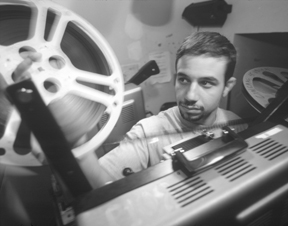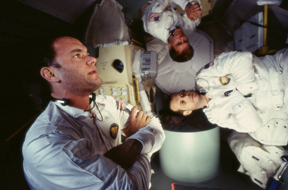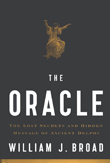|
Geomedia
Geotimes.org offers each month's book reviews, list of new books, book ordering information and new maps.
Check out this month's On the Web links, your connection to earth science friendly Web sites. The popular Geomedia feature is now available by topic.
Movies: Moviemaking with
science in mind
Books: Reaching beyond myth: A review of The
Oracle: The Lost Secrets and Hidden Message of Ancient Delphi
Moviemaking with science in mind
 After
recent studies uncovered a gap between American students and their international
counterparts in math and science performance, schools scrambled to hire
more teachers and change curriculums. But contributors to a Web site called
Sloan Science Cinémathèque suggest
a different approach to science education for general audiences: Take
them to the movies.
After
recent studies uncovered a gap between American students and their international
counterparts in math and science performance, schools scrambled to hire
more teachers and change curriculums. But contributors to a Web site called
Sloan Science Cinémathèque suggest
a different approach to science education for general audiences: Take
them to the movies.
New York University’s film school is one of six schools across the country where students are eligible to receive award money from the Alfred P. Sloan Foundation for incorporating science into their movies. Winning movies are then featured on the Sloan Science Cinémathèque Web site. Photo is courtesy of Tisch School of the Arts, NYU.
Not just any movie will do, however. Frankenstein-like movies can mislead audiences with inaccurate portrayals of mad scientists and experiments gone awry, says David Schwartz, chief curator of film for the Museum of the Moving Image, based in Astoria, N.Y. Instead, movies need to portray scientists more accurately, while illuminating the scientific process.
The Museum of the Moving Image and the Alfred P. Sloan Foundation’s film program have joined to encourage such films through Sloan Science Cinémathèque. The site started in August 2005 as a platform for the Sloan Foundation to display students’ movies that received grants from the foundation. The site has since grown to include 18 short movies, as well as dialogues with directors and articles about science in film.
Sloan Science Cinémathèque is a “brilliant idea,” Schwartz says. The main aim is to convey to nonscientists a better understanding of science and technology and the people who work in those fields. They want to try “to humanize the subject,” and show that “underneath the white lab coat, there beats the all-too-recognizable human heart,” says Doron Weber, director of the Sloan Foundation’s Public Understanding of Science and Technology program. Schwartz thinks that Sloan Science Cinémathèque could also “get people interested in being scientists, going into careers in science, or at the very least thinking about science.” A good way to do that, he says, is through movies.
Consider director Ron Howard’s Apollo 13. Science alone might not seem like the most exciting thing to put on film, Schwartz says. But in Apollo 13, audiences watched science in action, as engineers worked together to arrive at life or death solutions to a number of challenges faced by mission members of the ill-fated craft on its trip to the moon. Howard was “brilliant” in dramatizing the events that make science exciting, Schwartz says, which is the foundation’s “ultimate challenge” to filmmakers.
 Visitors to Sloan Science Cinémathèque can read a dialogue
with Ron Howard about science in Apollo 13. They can also watch
films on the site that are directed by students, who the Sloan Foundation
thinks could be the next generation of “Ron Howards,” and big-name
Hollywood directors, Weber says. “We’re picking the talented
kids early in their career and exposing them to science and technology,”
Weber says, subjects for which he hopes students will decide to “work
their magic.”
Visitors to Sloan Science Cinémathèque can read a dialogue
with Ron Howard about science in Apollo 13. They can also watch
films on the site that are directed by students, who the Sloan Foundation
thinks could be the next generation of “Ron Howards,” and big-name
Hollywood directors, Weber says. “We’re picking the talented
kids early in their career and exposing them to science and technology,”
Weber says, subjects for which he hopes students will decide to “work
their magic.”
Creators of Sloan Science Cinémathèque cite Ron Howard’s Apollo 13, starring Tom Hanks, as a prime example of a movie that brings science to broad audiences with good excitement and drama. Photo is copyright of Universal Pictures.
Andy Watts tackled science in Concrete, which he wrote and directed in 2000 while at Columbia University in New York City — one of six film schools across the country that participate in Sloan Science Cinémathèque. The film features a botanist in New York City who studies greenery for its potential to clean the city’s polluted air. The scientist steals a young girl’s garden (a weed growing in a crack in the sidewalk) for his research, and conflict ensues. By the end of the film, however, the scientist befriends the girl and makes amends by tearing away city concrete to plant a garden for her.
Watts’ inspiration for the film came from the contrast between the city’s concrete and rooftop greenery, according to a Sloan Science Cinémathèque summary of the film. He worked closely, however, with a graduate student at Columbia studying how plants can be used to clean pollution in the soil, or phytoremediation — a term smuggled into the film’s dialogue.
Extra incentive for Watts and other students to tackle science in their films, when they might not have thought to otherwise, comes from the Sloan Foundation’s grants, Weber says. The foundation uses grant money to “lure them,” he says, and in the moviemaking process, he hopes young filmmakers “develop an appetite” for science.
Weber says that future films by today’s science-inspired film students will appear in theaters and reach the broadest possible audiences. Exposure to science is necessary in a modern country that thrives on science and technology, he says, yet “people don’t know much about it.” Science is “couched in stereotypes,” and people fear unfamiliar subjects, he says.
Future big-screen films that counter stereotypes of scientists begin with today’s film students, Weber says. An upcoming commercial film about Nobel Prize winner Richard Feynman called Challenger will tackle some of those stereotypes, he says, and bring to light the physicist who advanced the field of quantum electrodynamics and popularized the field with his quirky lectures and books. Media 8 Entertainment announced May 23 that they will make the movie, which will star actor David Strathairn (of Good Night, and Good Luck) as Feynman and be directed by Philip Kaufman (of The Right Stuff). The original script for Challenger, however, came from screenwriter Nicole Perlman, who won a Sloan Foundation award for the script, which she wrote as an undergraduate at New York University.
Also look for student film The First Vampire, coming soon to Sloan Science Cinémathèque. The film features mythical vampires, but also the chemist who considered a link between vampire folklore and a real medical condition called porphyria — an enzyme disorder that affects the nervous system and results in light sensitivity, among other conditions. At first, Weber says, he was skeptical about the topic, but after reading the film’s script, he now calls it “intelligent and probing,” and a good example of what Sloan Science Cinémathèque looks for.
Creators of Sloan Science Cinémathèque will have to wait and see if current young directors awarded grants continue to incorporate science into their films, and if those films can change how Americans view science. Schwartz says that he is optimistic that the effort will pay off. After all, he says, “everybody loves movies.”
Kathryn HansenLinks:
Sloan
Science Cinémathèque
Book review
 The
Oracle: The Lost Secrets and Hidden Message of Ancient Delphi The
Oracle: The Lost Secrets and Hidden Message of Ancient Delphiby William J. Broad. The Penguin Press, 2006. ISBN I 5942 0081 5 Hardcover, $25.95. |
George Davis
William J. Broad, senior writer at The New York Times and two-time Pulitzer Prize winner, takes us to the interface of geology and archaeology in Delphi, along the base of Mount Parnassus in Greece in his recent book The Oracle. His seeks to demystify the prophetic Oracle of Greek mythology by probing what is myth, what is reality and what is misconception.
The trigger for Broad’s story was a paper published in Geology in August 2001 by Jeller de Boer, John Hale and Jeffrey Chanton (see Geotimes, May 2002). The article confirmed what I had myself seen at Delphi circa 1988 — the gorgeous, conspicuous, giant fault structures that pass along the front of Mount Parnassus and through the base of the Temple of Apollo. The paper also confirmed what I had heard at Delphi — that the Oracle’s mythical speaking in tongues was prompted by the influence of inhaling vapors escaping from fissures and fractures in the bedrock foundation of the Oracle’s chambers.
Broad’s vehicle for telling the story is the investigative work of two unlikely partners: de Boer, a Wesleyan University geologist, and Hale, a University of Louisville archaeologist. In the book, Broad introduces these academics in a leisurely way, after first presenting a primer on the history of ancient Greece in ways primarily centered on the ubiquitous role of the Oracle in ancient Greek society and religion. The de Boer and Hale partnership of investigation and discovery was exemplary of the scientific process: curiosity-driven and open to the unexpected, with a penchant for debate and a healthy dose of serendipity. The flow of the book allows readers to grasp how these characteristics of scientific investigation are antipodal to antecedent investigations at Delphi.
As such, Broad could have written this book as a completely upbeat romantic nanochapter of the history of science: starting with the beauty of nature, proceeding with the incompleteness and misguided conclusions of certain earlier French archaeologists and English geologists, and closing with de Boer and Hale demonstrating the power of multiple working hypotheses in discerning truth and exposing past sins of dogmatism. But he takes us deeper, notifying us in the prologue that there is more at stake: “Science may be our religion. But the dirty little secret . . . is that it is more a loose collection of insights and slogans than a universal explanation for what is real.” The book, he says, is a documentation of how science regularly overreaches.
Those who “overreached” are dubbed by Broad “Doubters” (the title of the second chapter). They are the skeptical archaeologists and classicists who in the late 19th century and first half of the 20th century refuted the ancient record with their modern findings, creating a literature with such impact that scholars no longer believed in the existence of the vapors and their influence upon the Oracle.
Looking back, Broad would regard these investigators as proponents of “reductive naturalism,” who argue that the nature of reality is completely physical, and that nothing exists beyond physical objects and their properties. Not until de Boer and Hale did most scholars again take seriously the springs and the fumes. In a way, Broad introduces himself as the voice of the Oracle, questioning modern science, and advocating for a voice of pluralism in inquiry and interpretation.
For me the juxtaposition of the “dirty little secret” and the romance of the place is both jarring and provocative, though I prefer the romance. I do question, however, whether the labeling of most science as “reductive naturalism” should have held such a prominent place in the context of this particular story, which ends in winsome and honest collegial work carried out by de Boer and Hale — the heroes, who in the final chapter topple the erroneous conclusions and dogmatism of scientific forebears at Delphi, and who appear to understand that their own conclusions are just a part of a picture that will never be fully understood.
Overall, though, I like the book. I am pleased to be reminded so graphically of examples where politics and hubris despoil science and scientific objectives. Also, I thank Broad for helping me to appreciate the reach of the Oracle beyond Delphi — over time, over distance, over politics, over religion and over leadership.
Furthermore, I discovered through his book the extraordinary saga of the life of de Boer, who, just for starters, as a boy survived a Japanese concentration camp during World War II. We see in de Boer the combination of disciplines and life and work experiences that could not have been improved upon in this out-of-the-blue assignment. We also see in Hale the very partner that de Boer needed most, energetically and enthusiastically following every lead and bringing his considerable archaeological wisdom to bear on the issues. Having met Hale (he lectured in my class at the University of Arizona), I can “see” him as big as life in Broad’s book.
I would have liked to see a few illustrations of faults and faulting, to complement Broad’s well-crafted words. He could have found an image with a relevancy and impact equivalent to his choice of art on page 35, which shows the Oracle while prophesizing, done by an Athenian potter around 440 B.C.
Furthermore, I would have wanted to describe to him the elegance and character of contemporary active tectonics in Greece, which is pulling apart the land and causing subsidence. This stretching applies to the eastern Mediterranean over the past 25 million years and lends itself beautifully to completely understanding the tectonic setting of Delphi and the issuing of gases from fissures and faults.
In the end, though, it is a story about broad-gauged field investigators, humbled by Earth, its elegance and its mysteries. This book is at least three reads in one. I recommend it highly, not only to archaeologists and geologists, but also to independent thinkers in general.
Davis specializes in structural geology and is a professor in the department of geosciences at the University of Arizona in Tucson, where he is also executive vice president and provost.
Links:
"Ancients
right about Delphi," Geotimes, May 2002

 Subscribe
Subscribe

